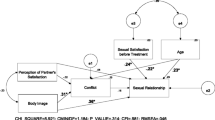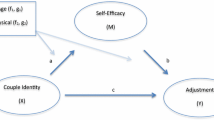Abstract
In this cross-sectional study we analyzed the links between marital quality and intimacy, body image, and psychological quality of life (PQoL) of breast cancer patients, as well as the moderating role of cancer phase (treatment, survivorship) on the aforementioned links. We also evaluated whether body image mediated the associations between marital relationship variables and PQoL. An analysis of the data from 128 patients (66 undergoing treatment, 62 survivors) indicated that the majority of links between variables were significant only during the treatment phase. Mediating effect of body image on the associations between relationship variables and PQoL was found only at the treatment phase.



Similar content being viewed by others
References
Aiken, L., & West, S. (1991). Multiple regression: Testing and interpreting interactions. Thousand Oaks: Sage Publications, Inc.
Bloom, J., Stewart, S., Chang, S., & Banks, P. (2004). Then and now: Quality of life of young breast cancer survivors. Psycho-Oncology, 13, 147–160.
Bloom, J., Stewart, S., Johnston, M., Banks, P., & Fobair, P. (2001). Sources of social support and the physical and mental well-being of young women with breast cancer. Social Science and Medicine, 53, 1513–1524.
Boyes, A., Fletcher, G., & Latner, J. (2007). Male and female body image and dieting in the context of intimate relationships. Journal of Family Psychology, 21(4), 764–768.
Brennan, J. (2001). Adjustment to cancer—coping or personal transition? Psycho-Oncology, 10, 1–18.
Broderick, C. (1993). Understanding family process: Basics of family systems theory. Thousand Oaks, CA: Sage Publications, Inc.
Browall, M., Ahlberg, K., Karlsson, P., Danielson, E., Persson, L.-O., & Gaston-Johansson, F. (2008). Health-related quality of life during adjuvant treatment for breast cancer among postmenopausal women. European Journal of Oncology Nursing, 12, 180–189.
Burman, B., & Margolin, G. (1992). Analysis of the association between marital relationships and health problems: An interactional perspective. Psychological Bulletin, 112(1), 39–63.
Carver, C., Pozo-Kaderman, C., Price, A., Noriega, V., Harris, S., Derhagopian, R., et al. (1998). Concern about aspects of body image and adjustment to early stage breast cancer. Psychosomatic Medicine, 60, 168–174.
Cash, T. (1997). The body image workbook: An 8-step program for learning to like your looks. Oakland, CA: New Harbinger Publications, Inc.
Cash, T. (2002). Cognitive-behavioral perspectives on body image. In T. Cash & T. Pruzinsky (Eds.), Body Image: A handbook of theory, research, and clinical practice (pp. 38–46). New York: The Guilford Press.
Collins, N. L., & Feeney, B. C. (2004). An attachment theory perspective on closeness and intimacy. In D. J. Mashek & A. Aron (Eds.), Handbook of closeness and intimacy. New Jersey & London: Lawrence Erlbaum.
Creamer, M., Burgess, P., & Pattison, P. (1992). Reaction to trauma: A cognitive processing model. Journal of Abnormal Psychology, 101, 452–459.
Dorval, M., Maunsell, E., Deschênes, L., Brisson, J., & Masse, B. (1998). Long-term quality of life after breast cancer: Comparison of 8-year survivors with population controls. Journal of Clinical Oncology, 16, 487–494.
Dow, K., Ferrell, B., Leigh, S., Ly, J., & Gulasekaram, P. (1996). An evaluation of the quality of life among long-term survivors of breast cancer. Breast Cancer Research and Treatment, 39, 261–273.
Ferrell, B. R., Dow, K. H., Leigh, S., Ly, J., & Gulasekaram, P. (1995). Quality of life in long-term cancer survivors. Oncology Nursing Forum, 22(6), 915–922.
Figueiredo, M., Fries, E., & Ingram, K. (2004). The role of disclosure patterns and unsupportive social interactions in the well-being of breast cancer patients. Psycho-Oncology, 13(2), 96–105.
Friedman, M., Dixon, A., Brownell, K., Whisman, M., & Wilfle, D. (1999). Marital status, marital satisfaction, and body image dissatisfaction. International Journal of Eating Disorders, 26, 81–85.
Frost, M., Suman, V., Rummans, T., Dose, A., Taylor, M., Novotny, P., et al. (2000). Physical, psychological and social well-being of women with breast cancer: The influence of disease phase. Psycho-Oncology, 9, 221–231.
Giese-Davis, J., Hermanson, K., Koopman, C., Weibel, D., & Spiegel, D. (2000). Quality of couples’ relationship and adjustment to metastatic breast cancer. Journal of Family Psychology, 14, 251–266.
Greeff, A., & Malherbe, H. (2001). Intimacy and marital satisfaction in spouses. Journal of Sex and Marital Therapy, 27, 247–257.
Hartl, K., Janni, W., Kastner, R., Sommer, H., Strobl, B., Rack, B., et al. (2003). Impact of medical and demographic factors on long-term quality of life and body image of breast cancer patients. Annals of Oncology, 14, 1064–1071.
Hayes, A. (2009). Beyond Baron and Kenny: Statistical mediation analysis in the new millennium. Communication Monographs, 76(4), 408–420.
Helgeson, V., & Cohen, S. (1996). Social support and adjustment to cancer: Reconciling descriptive, correlational, and intervention research. Health Psychology, 15(2), 135–148.
Hopwood, P., Fletcher, I., Lee, A., & Al Ghazal, S. (2001). A body image scale for use with cancer patients. European Journal of Cancer, 37, 189–197.
Knobf, M. T. (2007). Psychosocial responses in breast cancer survivors. Seminars in Oncology Nursing, 23(1), 71–83.
Kornblith, A. (1998). Psychosocial adaptation of cancer survivors. In J. Holland (Ed.), Psycho-oncology (pp. 223–254). New York: Oxford University Press.
Lemieux, J., Maunsell, E., & Provencher, L. (2008). Chemotherapy-induced alopecia and effects on quality of life among women with breast cancer: A literature review. Psycho-Oncology, 17(4), 317–328.
Lepore, S., Ragan, J., & Jones, S. (2000). Talking facilitates cognitive-emotional processes of adaptation to an acute stressor. Journal of Personality and Social Psychology, 78(3), 499–508.
MacKinnon, D. P., Lockwood, C. M., & Williams, J. (2004). Confidence limits for the indirect effect: Distribution of the product and resampling methods. Multivariate Behavioral Research, 39, 99–128.
Manne, S. (1994). Couples coping with cancer: Research issues and recent findings. Journal of Clinical Psychology in Medical Settings, 1(4), 317–330.
Manne, S., & Badr, H. (2008). Intimacy and relationship processes in couples’ psychosocial adaptation to cancer. Cancer, 112(11 suppl), 2541–2555.
Manne, S., & Badr, H. (2010). Intimacy processes and psychological distress among couples coping with head and neck or lung cancers. Psycho-Oncology, 19(9), 941–954.
Manne, S., Badr, H., Zaider, T., Nelson, D., & Kissane, D. (2010). Cancer-related communication, relationship intimacy, and psychological distress among couples coping with localized prostate cancer. Journal of Cancer Survivorship, 4(1), 74–85.
Manne, S., & Glassman, M. (2000). Perceived control, coping efficacy, and avoidance coping as mediators between spouses’ unsupportive behaviors and cancer patients’ psychological distress. Health Psychology, 19(2), 155–164.
Manne, S., Ostroff, J., Winkel, G., Fox, K., Grana, G., Miller, E., et al. (2005). Couple-focused group intervention for women with early stage breast cancer. Journal of Consulting and Clinical Psychology, 73(4), 634–645.
Moreira, H., Amaral, A., & Canavarro, M. C. (2009). Adaptação do personal assessment of intimacy in relationships scale (PAIR) para a população Portuguesa: Estudo das suas características psicométricas. [Adaptation of the personal assessment of intimacy in relationships scale (PAIR) for the Portuguese population: Study of its psychometric properties]. Psychologica, 50, 353–373.
Moreira, M., Silva, S., & Canavarro, M. C. (2010a). The role of appearance investment in the adjustment of women with breast cancer. Psycho-Oncology, 19, 959–966.
Moreira, M., Silva, S., Marques, A., & Canavarro, M. C. (2010b). The Portuguese version of the body image scale (BIS)—psychometric properties in a sample of breast cancer patients. European Journal of Oncology Nursing, 14, 111–118.
Moyer, A. (1997). Psychosocial outcomes of breast-conserving surgery versus mastectomy: A meta-analytic review. Health Psychology, 16(3), 284–298.
Moyer, A., & Salovey, P. (1996). Psychosocial sequelae of breast cancer and its treatment. Annals of Behavioral Medicine, 18(2), 110–125.
Nosarti, C., Roberts, J., Caryford, T., McKenzie, K., & David, A. (2002). Early psychological adjustment in breast cancer patients: A prospective study. Journal of Psychosomatic Research, 53, 1123–1130.
O’Mahoney, J., & Carroll, R. (1997). The impact of breast cancer and its treatment on marital functioning. Journal of Clinical Psychology in Medical Settings, 4(4), 397–414.
Peuckmann, V., Ekholm, O., Rasmussen, N. K., Moller, S., Groenvold, M., Christiansen, P., et al. (2007). Health-related quality of life in long-term breast cancer survivors: Nationwide survey in Denmark. Breast Cancer Research and Treatment, 104(1), 39–46.
Pikler, V., & Winterowd, C. (2003). Racial and body image differences in coping for women diagnosed with breast cancer. Health Psychology, 22(6), 632–637.
Pistrang, N., & Barker, C. (1995). The partner relationship in psychological response to breast cancer. Social Science Medicine, 40(6), 789–797.
Prager, K. J. (1995). The psychology of intimacy. New York: The Guilford Press.
Prager, K. J., & Buhrmester, D. (1998). Intimacy and need fulfillment in couple relationship. Journal of Social and Personal Relationships, 15, 435–469.
Preacher, K., & Hayes, A. (2004). SPSS and SAS procedures for estimating indirect effects in simple mediation models. Behavior Research Methods, Instruments, & Computers, 36(4), 717–731.
Preacher, K., & Hayes, A. (2008). Asymptotic and resampling strategies for assessing and comparing indirect effects in multiple mediator models. Behavior Research Methods, 40(3), 879–891.
Reis, H. T., & Patrick, B. (1996). Attachment and intimacy: Component processes. In T. Higgins & A. Kruglanski (Eds.), Social psychology: Handbook of basic principles. New York: The Guilford Press.
Reis, H. T., & Shaver, P. (1988). Intimacy as an interpersonal process. In S. Duck (Ed.), Handbook of personal relationships (pp. 367–389). Chichester: Wiley.
Rolland, J. (1994). Families, illness, and disability: An integrative treatment model. New York: Basic Books.
Schaefer, M., & Olson, D. (1981). Assessing intimacy: The PAIR inventory. Journal of Marital and Family Therapy, 7(1), 47–60.
So, W., Marsh, G., Ling, W., Leung, F., Lo, J., Leung, M., et al. (2010). Anxiety, depression and quality of life among Chinese breast cancer patients during adjuvant treatment. European Journal of Oncology Nursing, 14(1), 17–22.
Tomich, P., & Helgeson, V. (2002). Five years later: A cross-sectional comparison of breast cancer survivors with healthy women. Psycho-Oncology, 11, 154–169.
Vaz Serra, A., Canavarro, M. C., Simões, M., Pereira, M., Gameiro, S., Quartilho, M., et al. (2006). Estudos psicométricos do instrumento de Avaliação da Qualidade de Vida da Organização Mundial de Saúde (WHOQOL-bref) para Português de Portugal. [Psychometric studies of the World Health Organization Quality of Life Assessment (WHOQOL-Bref) for Portuguese from Portugal]. Psiquiatria Clínica, 27(1), 41–49.
Veach, T., Nicholas, D., & Barton, M. (2002). Cancer and the family life cycle: A practitioner’s guide. New York: Brunner-Routledge.
White, C. (2000). Body image dimensions and cancer: A heuristic cognitive behavioural model. Psycho-Oncology, 9, 183–192.
Whoqol-Group. (1998). Development of World Health Organization WHOQOL-bref Quality of Life Assessment. Psychological Medicine, 28, 551–558.
Zimmermann, T., Scott, J., & Heinrichs, N. (2010). Individual and dyadic predictors of body image in women with breast cancer. Psycho-Oncology, 19(10), 1061–1068.
Author information
Authors and Affiliations
Corresponding author
Rights and permissions
About this article
Cite this article
Moreira, H., Crespo, C., Paredes, T. et al. Marital Relationship, Body Image and Psychological Quality of Life among Breast Cancer Patients: The Moderating Role of the Disease’s Phases. Contemp Fam Ther 33, 161–178 (2011). https://doi.org/10.1007/s10591-011-9149-3
Published:
Issue Date:
DOI: https://doi.org/10.1007/s10591-011-9149-3




